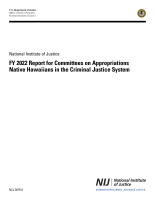Inmates
Changing Prison Culture Reduces Violence
Inmate Constitutional Rights and Exposure to Extreme Heat in Correctional Facilities
Relationship Between Inmate Misconduct, Institutional Violence, and Administrative Segregation: A Systematic Review of the Evidence
Modified TC for MICA Offenders: Crime Outcomes
Process Evaluation Assessing the Gender Appropriateness of the KEY/CREST Program, Executive Summary
Understanding Incarceration and Re-Entry Experiences of Female Inmates and their Children: The Women’s Prison Inmate Networks Study (WO-PINS)
Mitigating Contraband via the Mail: An Overview of Approaches for Managing the Introduction of Drug Contraband through the Digitization of Inmate Mail
Countering Threats to Correctional Institution Security: Identifying Innovation Needs to Address Current and Emerging Concerns
Preventing Violence and Sexual Assault in Jail: A Situational Crime Prevention Approach
Corrections Statistical Analysis Tool (CSAT) - Prisoners (Bureau of Justice Statistics)
This dynamic analysis tool allows you to examine national and jurisdictional data for both federal and state correctional authorities. You can view year-end populations, admissions, and releases by legal jurisdiction, physical custody in private facilities and local jails, imprisonment rate, citizenship status, prison capacity, juvenile or adult age group, and sex. The tool uses National Prisoner Statistics.
Recidivism of State Prisoners (Bureau of Justice Statistics)
BJS uses criminal history records to study the number and types of crimes committed by persons incarcerated in state prisons both prior to and following their release. The first study tracked a sample of persons incarcerated in state prisons released in 11 states in 1983, and the second study followed a sample of persons incarcerated in state prisons released in 15 states in 1994. Both...
National Prisoner Statistics (NPS) Program (Bureau of Justice Statistics)
Produces annual national- and state-level data on the number of prisoners in state and federal prison facilities. Aggregate data are collected on race and sex of prison inmates, inmates held in private facilities and local jails, system capacity, noncitizens, and persons age 17 or younger. Findings are released in the Prisoners series and the Corrections Statistical Analysis Tool (CSAT) - Prisoners.
Survey of Inmates in State Correctional Facilities (Bureau of Justice Statistics)
Conducted periodically, the survey provides information on individual characteristics of prison inmates, current offenses and sentences, characteristics of victims, criminal histories, family background, gun possession and use, prior drug and alcohol use and treatment, medical and mental health history and treatment, educational programs and other services provided while in prison, as well as other personal characteristics. Data are collected through personal interviews with a nationally...
Census of Jail Inmates (Bureau of Justice Statistics)
The 2005 Census of Jail Inmates is part of a series of data collection efforts aimed at studying the nation's locally-administered jails. To reduce respondent burden and improve data quality and timeliness, the Census was split into two data collections: the Census of Jail Inmates and the Census of Jail Facilities. The Census of Jail Inmates (CJI) collects data on jail jurisdictions' supervised populations, inmate...
Survey of Prison Inmates (Bureau of Justice Statistics)
Survey of Prison Inmates (SPI) is a periodic, cross-sectional survey of the state and sentenced federal prison populations.




